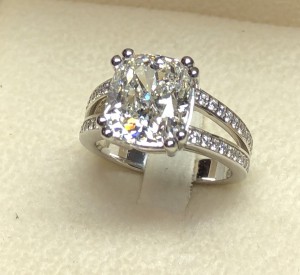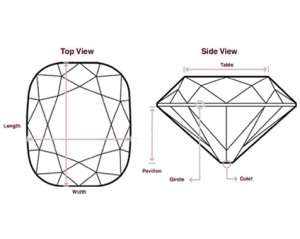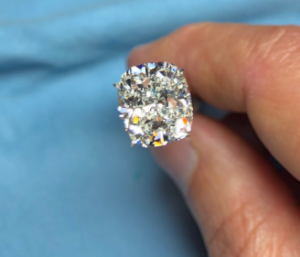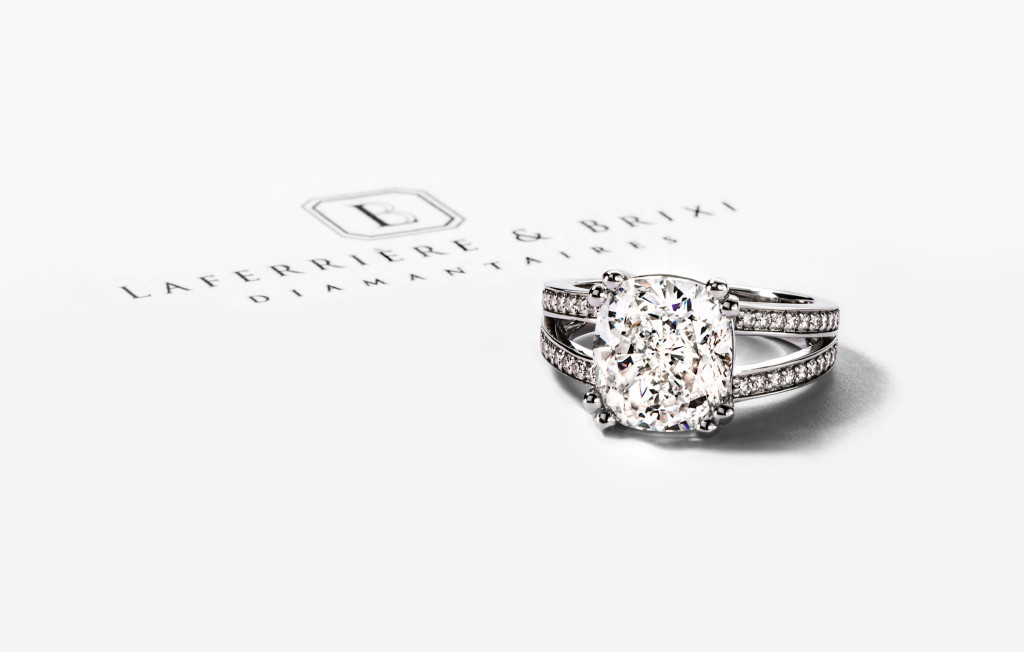Journey of a Large Rough Diamond
Diamonds are rare and precious stones that mark the imagination on more than one level. But only a few knows the true epic that surrounds the majestic stone shining through at the bottom of its mount of gold or platinum.
Here is the wonderful odyssey, from mine to finger, of an exceptional rough diamond acquired by Laferrière & Brixi. From its discovery at the end of the world, to the jewel crafted with art and passion, while going behind the scenes, where an extraordinary expertise lies.

In the Heart of Botswana
Our diamond begins its story as it is discovered as a rough stone in the heart of one of Botswana’s three diamond mines, namely Damtshaa, Jwaneng and Letlhakane.
2,276 milligrams of carbon crystallized in metamorphic stone by billions of years of extreme pressure and heat up to a thousand degrees Celsius, hundreds of kilometers below the ground, then propelled to the surface over the ages by volcanic eruptions.
Larger than most diamonds usually drilled in these mines with 11.38 carats, the gem is sent for observation to the largest and most advanced diamond sorting center in the world. It is recognized as a “Specials” diamond by De Beers, the company that jointly owns the mine with the Botswana government.
While the smaller stones are sold in batches, the diamond is reserved to be sold individually by auction to select buyers.
Journey Around the World
The gem begins a journey round the globe to be exposed in De Beers’ various establishments. From Singapore to New York, through Hong Kong, Antwerp in Belgium, Tel Aviv and Mumbai, the rough stone is presented to a select group of diamond experts from around the world with the ambition to acquire it.
Louis-Alexandre Laferrière, among the invited buyers, flies to New York to examine the stone and determine its value according to the 4 main qualities of a diamond, commonly called the 4 C: the cut, carats, color and clarity.
Then begins the auction process to determine who will have the privilege of acquiring the jewel in the making. Once the auction has been won, the diamond is sent to its new owner, Laferrière & Brixi Diamantaires, to initiate its valuation process.
In All Its Glory
Once the stone arrives at Laferrière and Brixi’s office, a new assessment stage begins. The question is now how to accurately determine how the rough diamond will be cut in order to extract the optimal shape while maintaining as much weight and clarity as possible.

Color
Although diamonds are most often imagined as brilliant stones without any color, they can actually exhibit differences in shades, between absolute transparency and off-white tints towards light brown.
They are graded on a color scale from “colourless” to “light color” thanks to a precise examination under a cold light, in order to discern the subtle color variations.
Some diamonds may have other special shades such as blue, green, yellow, orange, pink or red. These colored stones are classified as “coloured fancy”.
In this case, the examination revealed a beautiful whiteness, which constitutes a sought-after quality in colorless diamonds.
Carats
One of the first decisions the diamond dealer and tailor make, is how many diamonds will be crafted from the rough stone to keep the maximum weight possible.
Indeed, contrary to popular belief, carats refer to the weight of the diamond, not its size. 1 carat equals 200 mg or 5 carats for 1 gram. Large (and therefore heavier) diamonds are rarer than small diamonds, which is why a single large diamond is worth more than its weight in smaller diamonds.
By carefully examining our stone using sophisticated software, Louis-Alexandre and his tailor come to the conclusion that the best way to optimize the diamond and reduce losses is to make two pieces out of it.
The 11.38 carat gem is therefore cut to obtain a high clarity diamond of 6.01 carats and a smaller one of 1.04 carats with more inclusions.
Cut
Only element of the 4 C influenced by the human hand, the cut is actually what exerts the greatest influence on the brilliance of the diamond. The point is to qualify the quality of the multitude of facets of the diamond, as well as its ability to reflect the light intrinsically from one facet to another so as to project it towards the upper surface of the diamond.
The process of cutting or cleaving a diamond is a risky business because it has inner points of tension that could cause the stone to burst.
The decision to make two diamonds from the original gem is thus a risky bet that could be concluded in the loss of a portion of the diamond or all of it. Fortunately, the operation was a success thanks to the tailor’s mastery.
Once isolated, most of the diamond is cut into the “cushion” shape. This size, popular for over a century, has facets larger than many other popular cuts, so as to highlight the clarity of the diamond and its brilliance. The rectangular shape with rounded corners creates a beautiful harmony between geometry and softness for a look both modern and feminine.
The proportions of the multiple facets are meticulously calculated and cut with surgical precision to allow the diamond to shine brightly.
Clarity
When it comes to the clarity of a diamond, we are actually considering the degree of presence of inclusions. Inclusion is any solid, liquid or gaseous impurity that decreases the clarity of the diamond. They may be mineral veins, uncrystallized carbon or small visible fractures, more often seen with a magnifying glass or a microscope than the eye.
Since these impurities can influence the way the diamond reflects light, it is desirable to find the least possible, and smallest possible size, when examining the 10 times magnified diamond. The diamond receives a clarity code to signify how much inclusions it contains.
In its detailed evaluation, our diamond has revealed excellent clarity, so a small amount of inclusions, which gives it a magnificent shine.
A Highly Certified Diamond
The acquisition of a rough diamond, its transformation and its sale represent a process that few Canadian and Quebec diamond dealers master, among other things because of the administrative complexity that it represents in addition to the great expertise required.
Indeed, throughout the process of buying, processing and selling diamonds, certifications and associations are required to ensure their physical and ethical quality.
The American Gem Society
The diamond itself must undergo rigorous evaluation to obtain certification from the American Gem Society (AGS) or the Gemological Institute of America (GIA). These globally recognized laboratories have the authority to conduct a thorough assessment, make recommendations for the cut and issue an official diamond certification.
Indeed, a diamond classification report emitted by an independent laboratory provides an assurance of the objective characteristics of the gem for a fair evaluation of its value. The main objective of this process is the protection of consumers, who receive an unbiased opinion of the quality of the diamond they acquire.
A same diamond is sometimes sent several times to one or other of these institutions during the cutting phase. The recommendations made allow the diamond dealer and tailor to work the stone so as to give the final product an optimal quality.
Our diamond receives its certificate, an official document detailing all the gem’s attributes, its exact proportions through the 4 C and any additional observations deemed relevant by the American Gem Society.
Fair Trade Certified
Concerned about the global impact of the diamond industry, Laferrière & Brixi Diamantaires subscribe to the Canadian Diamond Code of Conduct and the Kimberley Process, an international commitment underpinned by the UN mandate.
All diamonds purchased and sold by the expert, whether they come from Canada’s Far North, Botswana or other mines around the world, are therefore certified ethical.
Thus, the person who acquires a stone from Laferrière & Brixi is guaranteed that it is not a conflict diamond.
A Unique Jewel
This diamond draws a part of its singularity in the linearity of its course. Indeed, if few diamond dealers acquire and process special (large) rough diamonds, even fewer are those who continue the process until the creation of custom jewelry.
The gem in question here is one of those exceptions.
After being cut into a diamond of great quality, the gem is presented among an assortment of jewels to a person in search of an exceptional stone.
Once they have made their mind and chosen the diamond, the future owner shares with Louis-Alexandre their ideas and preferences for the ring that will be tailor-made for them and for the diamond that will set it. Inspired by these indications, designs and wax casts are produced to allow the client to visualize unique model proposals.
When the design of the jewel is final, the ring is cast in the metal alloy chosen by the client. In this case, the ring hosting the diamond is platinum.
The diamond is finally set in the unique jewel, the breathtaking final touch on another bespoke and fully customized creations that make Laferrière & Brixi Diamantaires proud.
When it comes to selling, buying or transforming a stone as precious as a diamond, the expertise of a specialist is required. Laferrière & Brixi has specialized for over 15 years in the purchase and sale of exceptional diamonds. You are looking to buy or sell a diamond in your possession? Wait no longer.


